-
PDF
- Split View
-
Views
-
Cite
Cite
Xinhua Gao, Spatial structure and dynamical state of the old open cluster Collinder 261 based on a clustering method, Publications of the Astronomical Society of Japan, Volume 75, Issue 1, February 2023, Pages 82–89, https://doi.org/10.1093/pasj/psac091
Close - Share Icon Share
Abstract
In this paper, we investigate the memberships, spatial structure, and dynamical state of the old open cluster Collinder 261 (8 Gyr) based on Gaia-DR3 data. We develop a robust clustering method to calculate membership probabilities for 24858 sample stars within 20′ of the cluster center. We can identify 2619 likely cluster members (including 54 blue stragglers) down to G ∼ 20 mag. We use a Monte Carlo simulation method to estimate a distance of 2909 ± 90 pc for the cluster based on 281 high-probability members (P > 0.9). We find that the detectable cluster radius (Rcl) is at least 14′ (∼11.8 pc), which is much larger than previously thought. Based on the obtained cluster members, the core and tidal radii of the cluster are determined to be |$R_{\rm c}={3{^{\prime }_{.}}4}\pm {0.1}$| (∼2.9 ± 0.1 pc) and |$R_{\rm t}={19{^{\prime }_{.}}8}\pm {1{^{\prime }_{.}}9}$| (∼16.8 ± 1.6 pc), respectively. A concentration parameter of log (Rt/Rc) ∼0.76 is determined, indicating that Collinder 261 has formed a clear core–halo structure, but its spatial structure is much looser than the old open clusters M 67 (4 Gyr) and NGC 188 (7 Gyr). We also find that the membership probabilities are suitable for analyzing the mass segregation effect in the cluster. The orbit parameters show that Collinder 261 is moving along a near-circular orbit (e ∼ 0.025) well inside the solar circle (Rp ∼ 6.928 kpc, Ra ∼ 7.285 kpc), and it can reach a maximum height of Zmax ∼ 533 pc from the Galactic plane.
1 Introduction
Old open clusters have long been regarded as important tools for the studies of stellar evolution and dynamical evolution of stellar systems (Friel 1995). The catalog of Dias et al. (2021) contains fundamental parameters of 1743 open clusters, but only 193 (∼11%) clusters are older than 1 Gyr. Collinder 261 is an extremely old (∼8 Gyr) open cluster at a distance of ∼2800 pc (Froebrich et al. 2010; Dias et al. 2021) towards the direction of the Galactic Center (l = 301.°684, b = −5.°528).1 Collinder 261 may contain more than 2000 members within 10′ (∼8 pc) of the cluster center (Gao 2018b). All these make the rich cluster an important target for studying the stellar evolution, spatial structure, and dynamical state of old open clusters in the inner Galactic disk. Collinder 261 is relatively poorly studied, and its spatial structure and dynamical state remain poorly constrained. This is probably because Collinder 261 suffers from heavy field star contamination due to its distance and positions (Mazur et al. 1995; Gozzoli et al. 1996; Vats & van den Berg 2017). Mazur, Krzeminski, and Kaluzny (1995) found that Collinder 261 has an angular radius of at least 6′, corresponding to a linear radius of ∼5 pc at the cluster distance (2800 pc). However, this is probably a lower limit because the low-density cluster halo has not been taken into account (Mazur et al. 1995). Kharchenko et al. (2013) estimated a core radius of 2.5 pc (∼|${3{^{\prime }_{.}}1}$|) and a tidal radius of 17.36 pc (∼|${21{^{\prime }_{.}}3}$|) for the cluster assuming a cluster distance of 2800 pc. This core radius is consistent with the result (∼2.1 pc) determined by Vats and van den Berg (2017), but much larger than that (0.7 pc) obtained by Froebrich et al. (2010). These inconsistent results indicate that we do not fully understand the spatial structure of this rich cluster.
In this paper, our main goal is to investigate the spatial structure and dynamical state of Collinder 261, because they can provide important clues about the dynamical evolution of open clusters in the inner disk of the Galaxy. For this purpose, the first important step is to identify reliable member stars extended outward up to the cluster border. Reliable cluster members allow us to directly estimate the structural parameters of an open cluster even in noisy environments (Gao et al. 2021). In our previous work, a model-dependent method (GMM clustering) was used to identify about 2000 cluster members within 10′ of the cluster (Gao 2018b). However, the GMM method is not robust enough, and our member list probably does not include members in the outer regions of the cluster. Therefore, identifying reliable members over the whole cluster is essential in order to better understand the spatial structure and dynamical state of this highly relaxed cluster (Nilakshi et al. 2002; Chen et al. 2004; Sharma et al. 2006). In this paper, we will use the density-based spatial clustering of applications with noise (DBSCAN) algorithm (Ester et al. 1996), which is more robust than the GMM method, to calculate membership probability in a 2D input parameter space. We hope that this method can identify more reliable cluster members in a larger field of the cluster.
This paper is organized as follows. In section 2 we introduce the data and basic principles of the clustering method. In section 3 we investigate the distance, kinematics, and spatial structure of the cluster based on the obtained cluster members. The main conclusions in this work are given in the last section.
2 Data and method
2.1 Sample selection
The Gaia-DR3 catalog contains positions, parallaxes, proper motions, and photometric information in three bands (G, BP, and RP) for more than 1.8 billion sources brighter than G = 21 mag (Gaia Collaboration 2016, 2022). The precise 5D astrometric data allow us to identify more reliable cluster members for open clusters, even those in noisy environments (Gao 2018b; Gao et al. 2021). Based on Gaia-DR2 data, Cantat-Gaudin et al. (2018) have estimated some fundamental parameters for Collinder 261: central positions (l = 301.°696, b = −5.°537); proper motions (μαcos δ, μδ) = (−6.351 ± 0.004, −2.705 ± 0.004) mas yr−1; ϖ = 0.315 ± 0.002 mas. We select 24858 sample stars within a radius of 20′ from the cluster center based on the following criteria: (1) the stars must have three-band photometric information (G, BP, and RP); (2) the stars must have proper motions in the ranges of −10 ≤ μαcos δ ≤ −5 mas yr−1 and −5 ≤ μδ ≤ 0 mas yr−1; and (3) the stars must have parallaxes in the range of −0.2 ≤ ϖ ≤ 1 mas. Cantat-Gaudin et al. (2018) have determined 1858 cluster members (P > 0.5) brighter than G = 18 mag for Collinder 261, indicating that more than 90% of our sample stars may be field stars. Therefore, we need an effective method that is more robust than the GMM method to identify reliable cluster members in noisy environments.
2.2 Membership probability
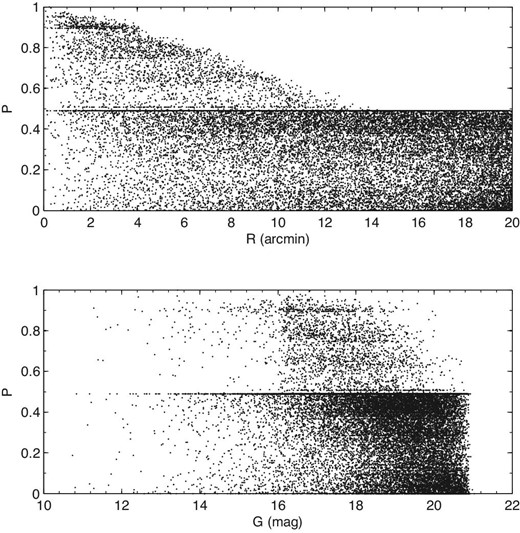
Membership probability (P) as a function of the distance from the cluster center (R) and G magnitude.
| Gaia-ID . | RA (°) . | Dec (°) . | P . |
|---|---|---|---|
| 5856527730243667584 | 301.68496266342 | −5.54193883801 | 0.965 |
| 5856527661485188864 | 301.68871871800 | −5.55161804222 | 0.965 |
| 5856527485397915264 | 301.70440386094 | −5.55179584161 | 0.965 |
| 5856527485419785216 | 301.70197761525 | −5.55609171089 | 0.962 |
| 5856527661524177792 | 301.68953364634 | −5.55240656918 | 0.962 |
| 5856528520517675520 | 301.69273945268 | −5.52322738300 | 0.959 |
| 5856527691559243648 | 301.70109707026 | −5.53351113499 | 0.956 |
| 5856527695883943040 | 301.70343660158 | −5.53217252233 | 0.956 |
| 5856527489686521984 | 301.69931993991 | −5.54980932886 | 0.952 |
| 5856527421006005760 | 301.70491375633 | −5.55844525564 | 0.952 |
| 5856527764603426176 | 301.69771867944 | −5.52705689874 | 0.952 |
| 5856527661485131648 | 301.68349921102 | −5.55674538629 | 0.952 |
| 5856527489725485824 | 301.70313241075 | −5.55518437254 | 0.952 |
| 5856528417403512704 | 301.65292545827 | −5.54316597677 | 0.952 |
| 5856528383039698176 | 301.66222340526 | −5.54670931870 | 0.952 |
| 5856528486157934720 | 301.68912307274 | −5.52414154019 | 0.952 |
| 5856527730204808320 | 301.68423996689 | −5.53384217973 | 0.952 |
| 5856527760276926592 | 301.70483219986 | −5.52521873392 | 0.952 |
| 5856527695849241856 | 301.70748277707 | −5.53824807650 | 0.952 |
| 5856527489725499264 | 301.70740734837 | −5.54549711847 | 0.952 |
| ...... | ...... | ...... | ...... |
| Gaia-ID . | RA (°) . | Dec (°) . | P . |
|---|---|---|---|
| 5856527730243667584 | 301.68496266342 | −5.54193883801 | 0.965 |
| 5856527661485188864 | 301.68871871800 | −5.55161804222 | 0.965 |
| 5856527485397915264 | 301.70440386094 | −5.55179584161 | 0.965 |
| 5856527485419785216 | 301.70197761525 | −5.55609171089 | 0.962 |
| 5856527661524177792 | 301.68953364634 | −5.55240656918 | 0.962 |
| 5856528520517675520 | 301.69273945268 | −5.52322738300 | 0.959 |
| 5856527691559243648 | 301.70109707026 | −5.53351113499 | 0.956 |
| 5856527695883943040 | 301.70343660158 | −5.53217252233 | 0.956 |
| 5856527489686521984 | 301.69931993991 | −5.54980932886 | 0.952 |
| 5856527421006005760 | 301.70491375633 | −5.55844525564 | 0.952 |
| 5856527764603426176 | 301.69771867944 | −5.52705689874 | 0.952 |
| 5856527661485131648 | 301.68349921102 | −5.55674538629 | 0.952 |
| 5856527489725485824 | 301.70313241075 | −5.55518437254 | 0.952 |
| 5856528417403512704 | 301.65292545827 | −5.54316597677 | 0.952 |
| 5856528383039698176 | 301.66222340526 | −5.54670931870 | 0.952 |
| 5856528486157934720 | 301.68912307274 | −5.52414154019 | 0.952 |
| 5856527730204808320 | 301.68423996689 | −5.53384217973 | 0.952 |
| 5856527760276926592 | 301.70483219986 | −5.52521873392 | 0.952 |
| 5856527695849241856 | 301.70748277707 | −5.53824807650 | 0.952 |
| 5856527489725499264 | 301.70740734837 | −5.54549711847 | 0.952 |
| ...... | ...... | ...... | ...... |
This table contains the Gaia-DR3 identifier, positions, and membership probability for the 2619 likely cluster members (P ≥ 0.5). Only a portion of this table is shown here to demonstrate its form and content; a machine-readable version of the full table is available.
| Gaia-ID . | RA (°) . | Dec (°) . | P . |
|---|---|---|---|
| 5856527730243667584 | 301.68496266342 | −5.54193883801 | 0.965 |
| 5856527661485188864 | 301.68871871800 | −5.55161804222 | 0.965 |
| 5856527485397915264 | 301.70440386094 | −5.55179584161 | 0.965 |
| 5856527485419785216 | 301.70197761525 | −5.55609171089 | 0.962 |
| 5856527661524177792 | 301.68953364634 | −5.55240656918 | 0.962 |
| 5856528520517675520 | 301.69273945268 | −5.52322738300 | 0.959 |
| 5856527691559243648 | 301.70109707026 | −5.53351113499 | 0.956 |
| 5856527695883943040 | 301.70343660158 | −5.53217252233 | 0.956 |
| 5856527489686521984 | 301.69931993991 | −5.54980932886 | 0.952 |
| 5856527421006005760 | 301.70491375633 | −5.55844525564 | 0.952 |
| 5856527764603426176 | 301.69771867944 | −5.52705689874 | 0.952 |
| 5856527661485131648 | 301.68349921102 | −5.55674538629 | 0.952 |
| 5856527489725485824 | 301.70313241075 | −5.55518437254 | 0.952 |
| 5856528417403512704 | 301.65292545827 | −5.54316597677 | 0.952 |
| 5856528383039698176 | 301.66222340526 | −5.54670931870 | 0.952 |
| 5856528486157934720 | 301.68912307274 | −5.52414154019 | 0.952 |
| 5856527730204808320 | 301.68423996689 | −5.53384217973 | 0.952 |
| 5856527760276926592 | 301.70483219986 | −5.52521873392 | 0.952 |
| 5856527695849241856 | 301.70748277707 | −5.53824807650 | 0.952 |
| 5856527489725499264 | 301.70740734837 | −5.54549711847 | 0.952 |
| ...... | ...... | ...... | ...... |
| Gaia-ID . | RA (°) . | Dec (°) . | P . |
|---|---|---|---|
| 5856527730243667584 | 301.68496266342 | −5.54193883801 | 0.965 |
| 5856527661485188864 | 301.68871871800 | −5.55161804222 | 0.965 |
| 5856527485397915264 | 301.70440386094 | −5.55179584161 | 0.965 |
| 5856527485419785216 | 301.70197761525 | −5.55609171089 | 0.962 |
| 5856527661524177792 | 301.68953364634 | −5.55240656918 | 0.962 |
| 5856528520517675520 | 301.69273945268 | −5.52322738300 | 0.959 |
| 5856527691559243648 | 301.70109707026 | −5.53351113499 | 0.956 |
| 5856527695883943040 | 301.70343660158 | −5.53217252233 | 0.956 |
| 5856527489686521984 | 301.69931993991 | −5.54980932886 | 0.952 |
| 5856527421006005760 | 301.70491375633 | −5.55844525564 | 0.952 |
| 5856527764603426176 | 301.69771867944 | −5.52705689874 | 0.952 |
| 5856527661485131648 | 301.68349921102 | −5.55674538629 | 0.952 |
| 5856527489725485824 | 301.70313241075 | −5.55518437254 | 0.952 |
| 5856528417403512704 | 301.65292545827 | −5.54316597677 | 0.952 |
| 5856528383039698176 | 301.66222340526 | −5.54670931870 | 0.952 |
| 5856528486157934720 | 301.68912307274 | −5.52414154019 | 0.952 |
| 5856527730204808320 | 301.68423996689 | −5.53384217973 | 0.952 |
| 5856527760276926592 | 301.70483219986 | −5.52521873392 | 0.952 |
| 5856527695849241856 | 301.70748277707 | −5.53824807650 | 0.952 |
| 5856527489725499264 | 301.70740734837 | −5.54549711847 | 0.952 |
| ...... | ...... | ...... | ...... |
This table contains the Gaia-DR3 identifier, positions, and membership probability for the 2619 likely cluster members (P ≥ 0.5). Only a portion of this table is shown here to demonstrate its form and content; a machine-readable version of the full table is available.
Cantat-Gaudin et al. (2018) have also determined membership probabilities for the cluster based on Gaia-DR2 data. They used the UPMASK clustering method to identify 1858 likely cluster members (P > 0.5) brighter than G = 18 mag. We make a comparison between the membership probabilities of 1972 common stars obtained by the UPMASK clustering method and our clustering method. Figure 2 shows that our low membership probabilities (P < 0.4) are relatively higher, while our high membership probabilities (P > 0.6) are relatively lower. Our member list includes some non-members in the catalog of Cantat-Gaudin et al. (2018), and some of our members have been identified as non-members by them (see figure 2). The discrepancies may be caused by the different principles of the two methods and the different precisions of the adopted astrometric data. The color–magnitude diagram (CMD) of the 2619 likely cluster members shows a well defined main sequence, main-sequence turn-off, and red giant branch (see figure 3). We find 54 blue stragglers, which are brighter and bluer than the turn-off stars, in the cluster according to the CMD of the likely cluster members (see figure 3). In addition, the positions (see figure 4) and proper motion vector point diagram (PM-VPD; see figure 5) of the likely cluster members also indicate the effectiveness of our membership determination. We find that the blue stragglers are more centrally concentrated than other cluster members, and 40 blue stragglers (∼74%) are located within the core radius of the cluster (∼|${3{^{\prime }_{.}}4}$|; see subsection 3.2). The blue stragglers have a high mean membership probability of 〈P〉 ∼0.84 because they are located in the inner regions of the cluster (see figure 1). These findings are consistent with the results reported by Rain et al. (2020), who identified 53 blue stragglers in the cluster and analyzed their various properties.
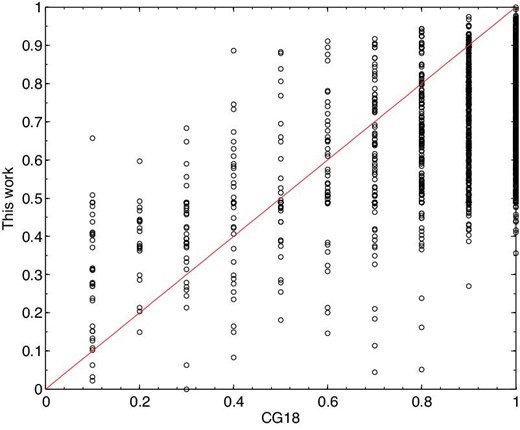
Comparison between the membership probabilities of 1972 common stars obtained by Cantat-Gaudin et al. (2018) (CG18) and our DBSCAN method.
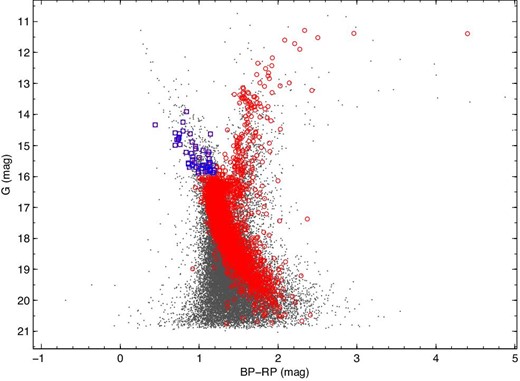
CMDs of the 2619 likely cluster members (P ≥ 0.5, red circles) and field stars (P < 0.5, gray dots); the blue squares indicate the 54 blue stragglers in the cluster.
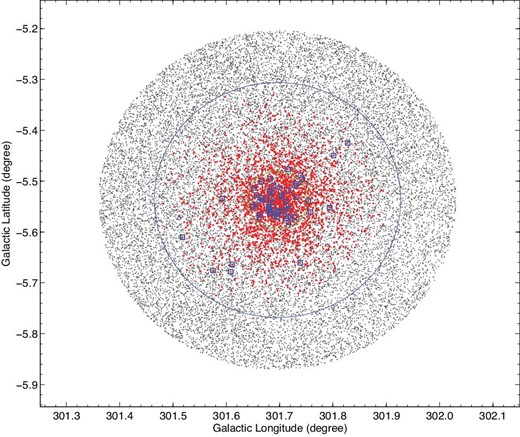
Positions of the likely cluster members (red dots), blue stragglers (blue squares), and field stars (gray dots); the green and blue circles indicate the estimated core and cluster radii (see subsection 3.2), respectively.
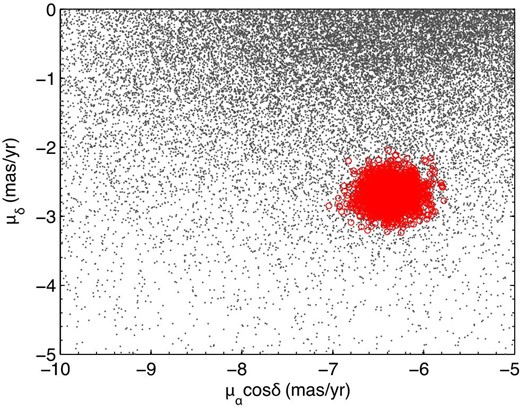
PM-VPDs of the likely cluster members (red circles) and field stars (gray dots).
Here, it should be noted that our membership determination, in principle, should take into account the observational errors of the 5D astrometric data. However, like most clustering algorithms, DBSCAN cannot deal with these observational errors. Fortunately, Gaia-DR3 provides relatively precise proper motions and positions for our sample stars, although the precisions of the parallaxes are relatively low.
3 Fundamental parameters
3.1 Distance and kinematics
Based on the membership probabilities, we have obtained 2619 likely cluster members for Collinder 261 down to G ∼20 mag. These reliable cluster members enable us to better estimate fundamental parameters for the cluster. The distance of the cluster is estimated based on the parallaxes of the 281 high-probability members with P > 0.9 using 100000 times Monte Carlo simulations (Gao et al. 2021) (see figure 6). This work does not take into account the zero-point offset in the Gaia-DR3 parallaxes, because this value may be very small and it actually varies with magnitude, color, and position on the sky (Lindegren et al. 2021; Riess et al. 2022). Taking into account the uncertainty (0.01 mas) on the absolute parallax (Riess et al. 2022), we determine a mean parallax of 〈ϖ〉 = 0.344 ± 0.011 mas, which corresponds to a distance of 2909 ± 90 pc. Our distance is quite consistent with previously published results within the uncertainties (Froebrich et al. 2010; Cantat-Gaudin et al. 2018; Dias et al. 2021). We find that 97 likely cluster members also have Gaia-DR3 radial velocities. Based on these cluster members, we use the Monte Carlo method to estimate the mean proper motions and radial velocity of the cluster. Our mean radial velocity and proper motions are 〈Vr〉 = −25.2 ± 0.3 km s−1 and 〈μαcos δ, μδ〉 = (−6.370 ± 0.005, −2.646 ± 0.006) mas yr−1, respectively. The distance and kinematics of the cluster are highly suitable for investigating the Galactic orbit of the cluster (see subsection 3.3).
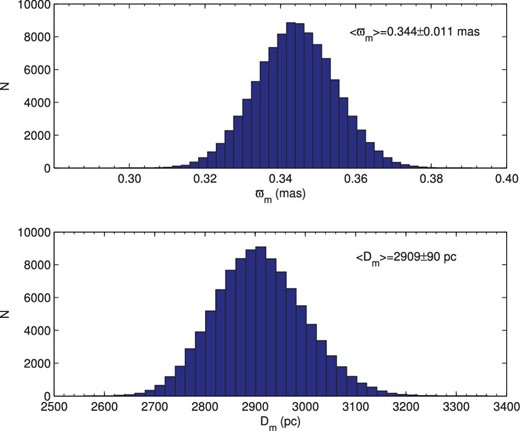
Monte Carlo simulations (100000 times) of the mean parallax (top) and distance (bottom) for Collinder 261.
3.2 Structural parameters
The cluster radius, core radius, and tidal radius of Collinder 261 are important parameters for understanding the spatial structure and dynamical state of the cluster. The cluster members allow us to directly estimate the cluster radius, since field star contamination has been greatly reduced. Figure 7 shows the distributions of the cluster members and field stars in the R–ϖ plane, where R and ϖ are the distance to the cluster center and parallax, respectively. We find that the cluster members extend outward up to ∼14′ (∼11.8 pc) from the cluster center. This indicates that Collinder 261 may have a cluster radius (Rcl) of at least 11.8 pc, which is much larger than previously thought (Mazur et al. 1995; Dias et al. 2002).
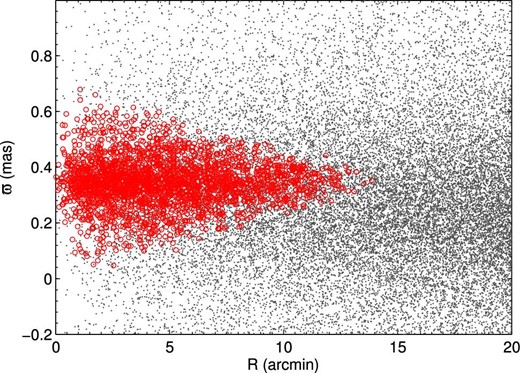
Distributions of the likely cluster members (red circles) and field stars (gray dots) in the R–ϖ plane.
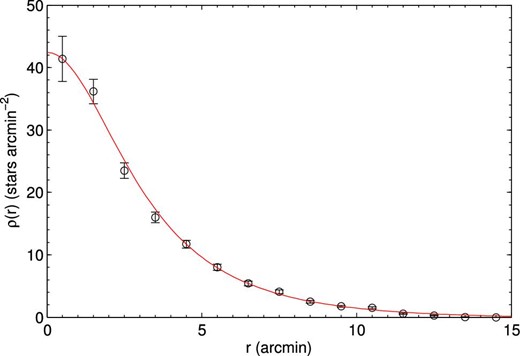
RDP of the 2619 likely cluster members and the fitted King profile (red line).
In addition, our membership probabilities are also suitable for analyzing the mass segregation effect in this old cluster, because relatively high-mass members located in the inner regions of the cluster also have higher membership probabilities. Figure 9 exhibits the cumulative G magnitude distributions of the cluster members with different membership probabilities. We find that the high-probability (P ≥ 0.8) cluster members, which are more centrally concentrated (see figure 1), are on average brighter than the low-probability members (0.5 ≤ P < 0.6), indicating that mass segregation has taken place within this old cluster. It should be noted that the lack of faint (G > 20 mag; see figure 3) low-mass members in the cluster may have weakened the mass segregation effect.
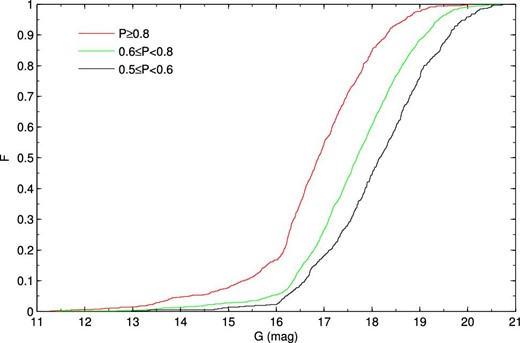
Cumulative G magnitude distributions of the cluster members with different membership probabilities.
3.3 The Galactic orbit
The Galactic orbits of open clusters can provide important clues about the formation and evolution of the Galactic disk. The Galactic orbit of Collinder 261 has been investigated by Wu et al. (2009), but they adopted a significantly smaller distance (2190 pc) for the cluster, and their adopted kinematics have relatively large uncertainties. Having obtained more reliable distance and kinematics, we can more accurately investigate the orbit parameters for the cluster. The galpy Python library2 is used to analyze the Galactic orbit based on the MWPotential2014 model (Bovy 2015). The Galactocentric distance of the Sun and the circular velocity at the Sun are R⊙ = 8.0 kpc and VLSR = 220 km s−1 (Bovy 2015), respectively. We adopt the solar motion (U⊙, V⊙, W⊙) = (11.1, 12.24, 7.25) km s−1 of Schönrich, Binney, and Dehnen (2010). The orbit of the cluster is calculated backwards within a time interval of 2 Gyr. The obtained orbit parameters show that Collinder 261 has a low orbit eccentricity e ∼ 0.025, an apogalactic distance Ra = 7.285 kpc, and a perigalactic distance Rp = 6.928 kpc (see figure 10). These results indicate that Collinder 261 is moving along a near-circular orbit well inside the solar circle (see figure 11). We also find that Collinder 261 can reach a maximum height of Zmax = 533 pc from the Galactic plane (see figure 10), which is significantly larger than that (220 pc) determined by Wu et al. (2009).
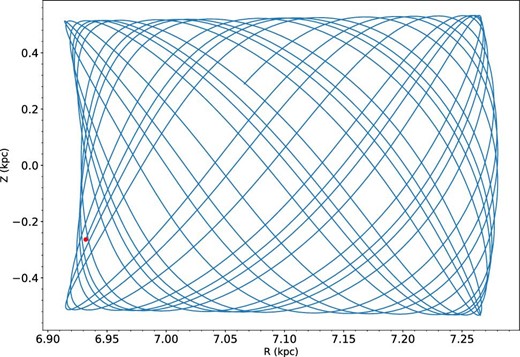
2D top view of the orbit for Collinder 261; the red dot indicates the current position of the cluster.

2D side view of the orbit for Collinder 261; the red dot indicates the current position of the cluster.
4 Conclusions and discussions
We use a simple and robust method to identify reliable cluster members in the old rich open cluster Collinder 261. Our method does not require two optimal input parameters, and it can calculate membership probability in a normalized 5D parameter space. It should be noted, however, that the grid of the parameters (see subsection 2.2) should be large enough to better identify cluster members. We identify 2619 likely cluster members (including 54 blue stragglers) in Collinder 261 according to the obtained membership probabilities. We find that the membership probabilities are suitable for analyzing the mass segregation effect in the cluster (see figure 9). We obtain more accurate fundamental parameters (distance, mean proper motions, and radial velocity) of the cluster based on these reliable cluster members. For the first time, we can directly detect the border of the cluster and estimate the cluster radius of Collinder 261. We find that Collinder 261 has a cluster radius of at least 14′ (∼11.8 pc). However, this value is only a lower limit because many faint (G > 20 mag; see figure 3) low-mass members are not included in our member list. These low-mass members are mainly distributed in the outer regions of the cluster due to mass segregation. We also estimate the core radius (2.9 pc) and tidal radius (16.8 pc) based on the obtained cluster members. Our results are consistent with those reported by Kharchenko et al. (2013). Our results indicate that Collinder 261 has formed a core–halo structure, but its concentration parameter (∼0.76) is significantly smaller than those of the old open clusters NGC 188 (∼1.1) and M 67 (∼1.1). This discrepancy may reflect that the spatial structure of Collinder 261 is strongly influenced by the strong tidal field of the Galaxy. Collinder 261 may have lost a significant number of low-mass members due to star evaporation and tidal stripping. In addition, based on the obtained distance and kinematics, we re-investigate the Galactic orbit of the cluster. We find that Collinder 261 is located well inside the solar circle (Ra = 7.285 kpc, Rp = 6.928 kpc) and has a low orbit eccentricity of e ∼ 0.025 and a large maximum height from the Galactic plane (Zmax = 533 pc).
Acknowledgements
We are grateful to the referee for valuable comments that have helped us to improve the manuscript. This research was supported by the Foundation of Changzhou University (Grant No. GJY21020056). This work has made use of data from the European Space Agency (ESA) mission Gaia (https://www.cosmos.esa.int/gaia), processed by the Gaia Data Processing and Analysis Consortium (DPAC, https://www.cosmos.esa.int/web/gaia/dpac/consortium). Funding for the DPAC has been provided by national institutions, in particular the institutions participating in the Gaia Multilateral Agreement. This research has made use of the VizieR catalog access tool, CDS, Strasbourg, France.
Conflict of interest
The author has declared no conflicts of interest for this article.
Data availability
All data included in this study are available upon request by contact with the orresponding author.



